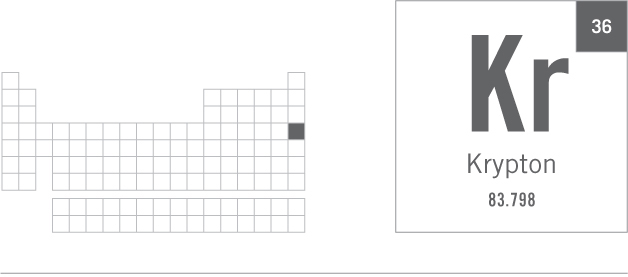As noble gas in group 18 shy krypton’s oh so rare,
For oh so long it hid from view, 1 ppm in air.
Now liquefied it flows just fine,
Our meter’s length it help’d define;
In high-power’d lasers, bulbs of light, flash-photos’ stark white glare.

As noble gas in group 18 shy krypton’s oh so rare,
For oh so long it hid from view, 1 ppm in air.
Now liquefied it flows just fine,
Our meter’s length it help’d define;
In high-power’d lasers, bulbs of light, flash-photos’ stark white glare.
THE FOURTH MEMBER OF THE GROUP 18 NOBLE GASES
Krypton is a colorless, odorless noble gas that takes its name from the Greek word kryptos, meaning hidden. It’s one of the rarest atmospheric gaseous elements, accounting for only one part per million (ppm) by volume in air. Krypton remained hidden (right under our noses!) until 1898, when it was discovered at University College, London by William Ramsay (1852–1916) and Morris William Travers (1872–1961). They allowed a sample of liquefied argon (previously extracted from air) to evaporate slowly, revealing the heavier krypton left behind.
Krypton is produced industrially via the fractional distillation of liquefied air. The process uses distillation to separate the liquefied air into its component parts or fractions (including krypton, oxygen, nitrogen, argon, and so on) based on the different boiling points of these fractions.
When atoms of any element are heated in, say, a flame, they absorb some of the flame’s thermal energy and are temporarily promoted into excited states, which are higher in energy. As they quickly revert to their normal state (which is lower in energy), they emit light. This phenomenon forms the basis of atomic emission spectroscopy, whereby each element emits light composed of a characteristic pattern of wavelengths. Between 1960 and 1983, the standard length of the meter was defined as exactly 1,650,763.73 times the wavelength of orange-red light emitted by the krypton-86 atom in a vacuum (a space absolutely devoid of matter). In 1983, this definition was replaced with the one still in use today, namely that the meter is the distance traveled by light in a vacuum in 1/299,792,458 of a second.
Krypton displays a predictably regal distain (in keeping with its status as a noble gas!) when it comes to interacting with the other elements. Although practically inert, it forms a limited number of compounds with the most reactive of all elements, fluorine. One of these compounds, krypton fluoride (KrF), is used in high-powered lasers for research purposes.
Krypton is also found as the inert gas inside certain higher-efficiency lightbulbs, where it facilitates the hotter (and therefore brighter) glow of the tungsten filament. Some fluorescent light tubes are filled with a mixture of krypton and argon gases.
Krypton gas discharge bulbs emit a brilliant bluish-white light, which is popular in certain types of flashes used in high-speed photography.